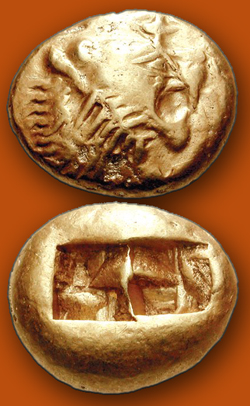By Dr. Sol Taylor
"Making Cents"
Saturday, November 3, 2007
| E |
|
For many years since, the definition of coinage has been, "a piece of material (usually metal) in a convenient standard size and shape which is stamped with the symbol of some authority vouching for its weight, fineness of metal and value."
Biblical references to currency prior to widespread use of coinage included such practical items as salt, grains, tools, cloth and many other products in commerce at the time.
Coinage came about at a time when it met certain needs including:
1) payment to soldiers in lieu of plunder;
2) a means to advertise the prestige and power of the issuing king, country or agency; and
3) to replace bulkier barter goods such as live animals, timber and slaves in general commerce.
The Lydian coinage as the replacement for barter is supported by writings of 6th-century author Xenophanes and 5th-century historian Herodotus.
More recent archaeological finds push back the coinage idea to early Egypt with finds of a hoard in 1906 at Dor, south of Haifa in modern Israel, that revealed metal rings and silver pieces (resembling bits of chocolate from a Hershey bar) dating from 1500 B.C.
Biblical references to Joseph and his brothers mentioned silver money in bags of grain which date them to about the 10th Century B.C., well before the Lydian coinage. The seals found on these grain bags showed the same ring money design. In addition, the silver bars appear to have a uniform size and weight and thus could have been early coinage predating the Lydian coinage.
In a more detailed odyssey of pre-Lydian coinage, author Marvin Tameanko, a retired professor of architecture in Toronto, outlines the stages of coinage and coin-like objects used in Biblical times as based on archaeological finds as well as writings and wall paintings. His book, "Monumental Coins: Buildings & Structures on Ancient Coinage," was published by Krause in 1999, and he followed it with an article titled, "A Biblical Forerunner of the First True Coins," in the April 2001 edition of the American Numismatic Association’s monthly journal, "The Numismatist.”
Primitive monies were in wide use while the civilized world relied more on coinage over the centuries. American Indians and early colonists relied on the standard Indian bead money or wampum for almost all trading purposes since the beads were uniform in size and belts or bands of beads had a specific value based on their bead count.
But because they bore no value inscription, they could not be called "coinage." In fact, more Indian beads were made by white men in mills using the same quahog shells and making uniformly sized beads. (Refer to my column on Wampum.)
Other coinage precursors include walrus skin money used in Alaska in the 18th and 19th century, cowry shells used by many Pacific Islanders, tea bricks used in central Asia into the 20th Century, and other standard non-coinage items used by native peoples and by traders in areas where coinage was not available or not preferred to local currency.
Then there is the whole field of tokens which, although they look like coinage, are not government-issued or -sanctioned for currency and thus are not considered coins. Tokens were in wide use throughout the world prior to the 20th Century.
The Lydian coins still hold the title of the earliest known coins, since they meet the coinage definition. The earlier pieces met the needs of commerce but were not coins as defined herein.
Dr. Sol Taylor of Sherman Oaks is president of the Society of Lincoln Cent Collectors and author of The Standard Guide to the Lincoln Cent. Click here for ordering information.
©2007 SCV COMMUNICATIONS GROUP & SOL TAYLOR · ALL RIGHTS RESERVED.

![[Most Recent Quotes from www.kitco.com]](http://www.kitconet.com/images/quotes_special.gif)

